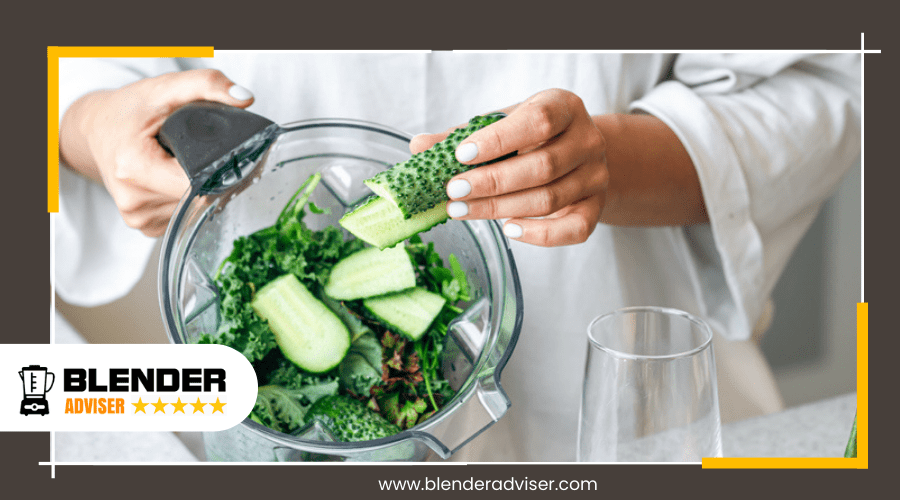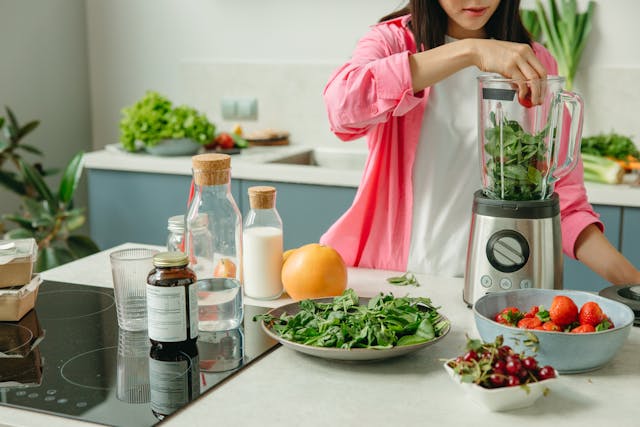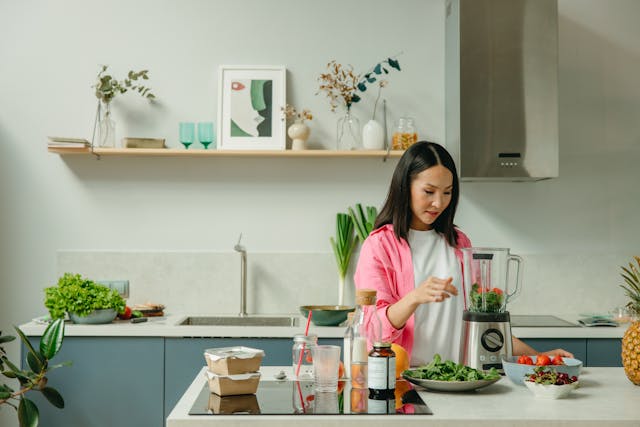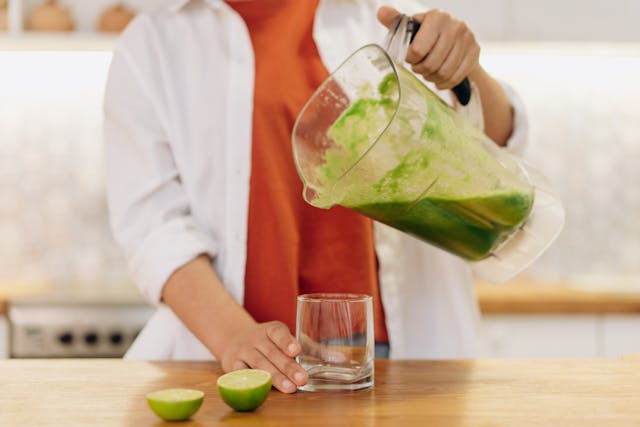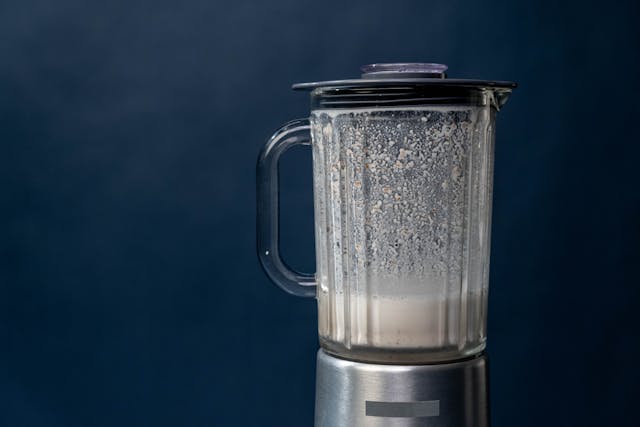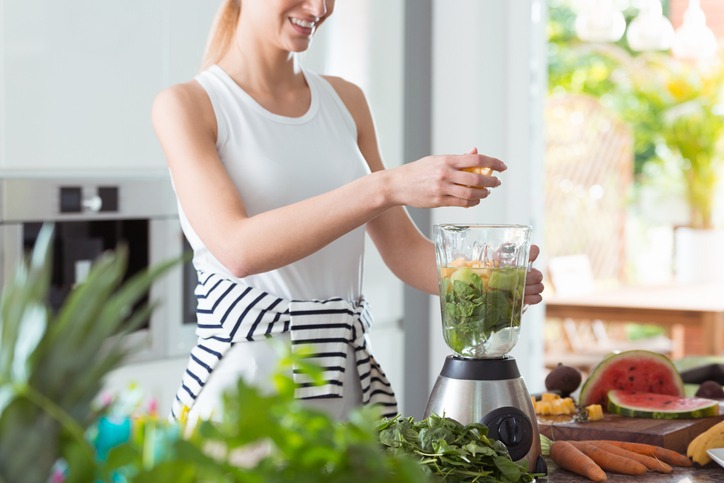Like a Swiss Army knife in the world of kitchen gadgets, your blender might just be the versatile tool you’re overlooking for chopping vegetables. You’re probably familiar with it smoothing out your morning smoothies, but with the right technique, it can also tackle the task of dicing veggies. It’s essential, however, to select a model with sharp blades and multiple speed options to avoid turning your carrots into carrot juice.
Before you resign to tedious hand-chopping or invest in a food processor, consider the potential sitting on your countertop. The secret lies in the method, and knowing the right steps could transform your meal prep experience.
Choosing the Right Blender
To efficiently chop vegetables, you’ll want to select a blender with sharp blades and multiple speed settings tailored for this task. A blender equipped with these features ensures that you have the control and efficiency needed to achieve the perfect consistency, whether you’re aiming for a finely chopped salad or a coarsely chopped salsa. It’s not just about the blades, though. The speed settings play a crucial role in how your vegetables turn out. With multiple options, you can fine-tune the chopping process, avoiding over-processing and ensuring your veggies are chopped to perfection.
Moreover, don’t overlook the importance of a blender’s construction and capacity. A sturdy blender can handle the tough task of chopping various vegetables, from soft tomatoes to hard carrots, without showing signs of wear and tear. The capacity of the blender jar is equally important. You’ll need a size that can accommodate the volume of vegetables you plan to chop. If you’re prepping meals for a family or batch cooking for the week, ensure your blender’s jar is up to the task. Choosing the right blender means balancing these features to meet your vegetable chopping needs.
Preparing Your Vegetables
Before you start blending, you’ll need to get your vegetables ready. Make sure to wash and peel them as needed to get rid of any dirt and achieve a smooth blend. Then, chop them into smaller, even pieces so they fit in your blender and chop uniformly.
Vegetable Size Consideration
When preparing your vegetables for the blender, start by cutting them into small, uniform pieces to ensure even chopping. It’s crucial you chop vegetables into sizes that easily fit into the blender.
This step helps avoid jamming the blades and promotes a smoother operation. You’re aiming for consistency in vegetable size, as this not only ensures an even blend but also contributes to the texture of the final chopped product.
Washing and Peeling Tips
Ensuring your vegetables are thoroughly washed and properly peeled is a crucial step in preparing them for a successful blend. Before you start chopping vegetables for your blender, it’s vital to remove any dirt and contaminants. This means giving them a good rinse under running water.
If necessary, peel the veggies to ensure you’re left with a clean and edible final product. Once they’re clean, cutting them into smaller pieces not only makes them easier to blend but also ensures they fit through your blender’s blades efficiently.
Remember to aim for uniformity in the size of the vegetable pieces. This promotes even blending and chopping results, making your culinary creations smoother and more consistent.
Adding Vegetables to Blender
To add vegetables to your blender, start by placing small batches inside to prevent overloading. This approach ensures that you’re not just mindlessly jamming veggies in, but rather thoughtfully preparing them for efficient chopping. It’s about making every chop count and achieving that perfect texture you’re after.
Here are a few reasons why this matters:
- You’ll avoid the frustration of a jammed or blocked blender, keeping your cooking experience smooth and enjoyable.
- It ensures even distribution, meaning each piece of vegetable gets equal attention, resulting in perfectly chopped bits that cook evenly.
- You’ll prevent unnecessary wear on your blender’s motor and blades, extending the life of your beloved kitchen ally.
- It’s a small step that leads to a big difference in the quality of your meals, impressing anyone who tastes your culinary creations.
Selecting the Appropriate Speed
To chop vegetables effectively in your blender, it’s essential to find the optimal speed range. Start by pulsing at a low speed for coarse chopping, ensuring you don’t end up with a puree. If you’re aiming for a smoother consistency, gradually increase the speed, but be mindful to not overdo it.
Identify Optimal Speed Range
Selecting the right speed setting, typically between 1 to 3 on the dial, is crucial for effectively chopping vegetables in a blender without turning them into a puree. Understanding the blender is vital for achieving the perfect texture. Different vegetables might require slight adjustments within this range. Here’s why getting the speed just right matters:
- It ensures your veggies retain their texture, avoiding a mushy outcome.
- Proper speed settings can preserve the nutritional integrity of your vegetables.
- It helps you achieve consistent chopping results, making your dishes look professional.
- Fine-tuning the speed can make the difference between a chunky salsa and a smooth sauce.
Experimenting within this optimal speed range is key to mastering vegetable chopping in your blender.
Pulse for Coarse Chopping
When you’re aiming for coarsely chopped vegetables, starting with the pulse function on your blender at a low speed can make all the difference. Unlike a food processor, where you might have more control, your blender requires a bit of finesse to avoid turning your veggies into a puree. By selecting a low speed and pulsing in short bursts, you maintain control over the chopping process, ensuring your vegetables reach that perfect coarse texture.
Remember to adjust the speed settings based on the type of vegetable you’re chopping and the level of coarseness you desire. With practice, you’ll find that pulsing at different speeds allows you to master the technique of coarse chopping with your blender, making it a versatile tool in your kitchen arsenal.
High Speed for Pureeing
After mastering the art of coarse chopping by pulsing at lower speeds, you’ll find that cranking up the blender to high speeds is key for achieving perfectly pureed vegetables. High-speed settings are your secret weapon for transforming rough cuts into smooth, creamy delights.
However, it’s crucial to select the appropriate speed to prevent over-processing and maintain the desired consistency. Here’s why:
- High speeds are ideal for pureeing, not chopping.
- Adjusting to lower settings helps achieve a chopped texture.
- Proper speed control prevents turning veggies into an unwanted puree.
- Selecting the right speed ensures you chop effectively, without overdoing it.
Shaking and Stirring Techniques
To achieve uniform chopping of all your vegetables, it’s crucial to occasionally stop the blender and employ shaking and stirring techniques. While you’re aiming to chop the vegetables to your desired size, remember that the way they’re positioned in the blender can affect the outcome significantly.
By stopping the blender from time to time, you give yourself the opportunity to gently shake the blender jar. This action helps to redistribute the vegetables inside, ensuring that every piece gets its turn near the blades. It’s a simple yet effective way to promote even chopping, preventing some pieces from becoming too fine while others remain chunky.
Moreover, don’t underestimate the power of a good stir. Using a spoon, you can manually stir the vegetables within the blender jar. This step is particularly useful for dislodging any large pieces that might’ve gotten stuck to the sides of the blender. Stirring helps to bring these stubborn chunks back into the path of the blades, where they can be chopped evenly along with the rest.
Checking the Consistency
Having employed shaking and stirring techniques to evenly chop your vegetables, it’s crucial to check their consistency before proceeding further. This step ensures that your culinary creations not only taste great but also look appealing on the plate. When you take a moment to examine the pieces, you’re looking for a few key indicators that you’ve achieved the perfect chop.
- Uniformity in size: Each piece should be roughly the same size for even cooking and a harmonious texture in every bite.
- Avoiding mushiness: It’s disappointing to find your vegetables have turned into a puree. Keeping an eye on the consistency prevents this culinary mishap.
- Adjusting as needed: Realizing that some pieces aren’t quite right allows you to make adjustments on the fly, ensuring the next batch is closer to perfection.
- Preventing wateriness: Too much blending can release water, turning your dish into a soggy mess. Checking consistency helps maintain the integrity of your vegetables.
Repeating Process for Bulk Chopping
When you’re chopping vegetables in bulk, start by working in small batches to avoid overloading the blender. This step is crucial to ensure that your blender can efficiently chop the vegetables without getting jammed or overworked. Make sure each batch of vegetables is evenly distributed in the blender. This helps maintain consistent chopping results, which is key when you’re dealing with a large quantity of vegetables.
As you proceed, it’s important to stop and shake the blender jar between batches. This simple action ensures that all vegetables get an equal opportunity to be chopped uniformly. You’ll notice that different types of vegetables may require slightly different handling. Some might need a higher speed, while others might get chopped perfectly at a lower setting. So, monitor the blade movement and adjust the speed settings as needed to achieve efficient chopping.
Practicing this chopping technique with various types of vegetables will help you understand their unique chopping requirements when processing in bulk. This knowledge is invaluable as it ensures that you can tackle any vegetable chopping task with confidence and ease, using your trusty blender.
Cleaning and Maintenance Tips
To keep your blender in prime condition for chopping vegetables, it’s crucial to adopt a regular cleaning routine and preventive maintenance measures. After each use, make sure you’re washing the jar, lid, and blades with warm, soapy water to prevent any buildup. Additionally, hand wash the blade assembly carefully and inspect for wear and tear, replacing parts as needed to ensure your blender operates at its best.
Regular Cleaning Routine
For optimal performance and longevity of your trusty blender, it’s crucial to establish a regular cleaning routine that includes scrubbing the jar, lid, and blades with warm, soapy water after every use. Regular maintenance ensures your blender remains reliable for your culinary adventures.
- Feel the satisfaction of cooking with a blender that’s always ready and efficient.
- Experience the joy of smooth operation without the frustration of leftover food particles.
- Enjoy the confidence in knowing your blender is clean, safe, and hygienic.
- Appreciate the peace of mind that comes from a well-maintained appliance, prolonging its life and protecting your investment.
Preventive Maintenance Measures
Beyond regular cleaning, taking preventive maintenance measures can significantly enhance your blender’s performance and lifespan. It’s not just about keeping it clean; it’s about ensuring it runs smoothly for years. Here’s a quick guide to blender maintenance:
| Maintenance Task | Why It Matters |
|---|---|
| Hand wash blade assembly | Prevents damage and ensures thorough cleaning. |
| Store in a dry place | Avoids rust and prolongs lifespan. |
| Check and replace parts | Prevents leakage and performance issues. |
Alternatives to Blending for Chopping
While blenders are convenient for many kitchen tasks, alternatives like food processors and manual tools offer more precision and control when chopping vegetables. Food processors, in particular, are often preferred for their precision cutting abilities. They allow you to achieve the exact size and texture you’re aiming for, something that’s harder to do with a blender’s more general blending action.
Consider these alternatives for chopping vegetables:
- Mandolines: Slice vegetables quickly and uniformly. Perfect for making gratins or chips, you’ll wonder how you ever cooked without one.
- Sharp knives: Nothing beats the control and satisfaction of chopping vegetables by hand. It’s a skill worth mastering for any home chef.
- Electric vegetable choppers: For those short on time, these gadgets can significantly speed up your meal prep process.
- Food processor attachments: Use a grater or shredder attachment to achieve finely chopped or grated vegetables effortlessly.
Each of these options provides a different experience in the kitchen, allowing you to customize cuts and textures in a way a blender simply can’t match. Embrace these tools to elevate your cooking and enjoy the process of preparing fresh, beautiful dishes.
Maximizing Your Blender’s Versatility
Exploring the full potential of your blender can transform it into an indispensable tool for chopping vegetables with ease. By leveraging the pulse or chop settings, you’re in control, avoiding pureeing and ensuring your veggies are perfectly prepped for your dish. It’s all about precision; these modes activate only when you press the button, allowing for effective shredding, mincing, and dicing.
Imagine whipping up salsas or casseroles with beautifully chopped ingredients straight from your blender. Yes, it’s possible when your appliance is equipped with the right functions. Brands like Oster recommend using blenders with chop or pulse buttons specifically for this purpose, emphasizing the importance of maintaining texture while chopping vegetables.
Your blender isn’t just for smoothies or soups; it’s a versatile ally in your culinary adventures. From shredding carrots for a salad to mincing garlic for a sauce, the possibilities are endless. So next time you’re in the kitchen, remember this: with the right technique, your blender can do much more than blend. It can chop vegetables efficiently, making your cooking process smoother and your meals more delightful.
Conclusion
Absolutely, you can use your blender to chop vegetables efficiently. Just ensure you’ve got a sharp-bladed, sturdy blender and prep your veggies by washing, peeling, and cutting them into smaller pieces. Add them in batches, adjust the speed wisely, and shake or stir as needed to get that perfect chop without turning them into a puree. Remember, with the right technique and maintenance, your blender can be a versatile tool, making chopping veggies a breeze.
Don’t forget to clean it well after use!

